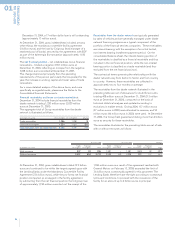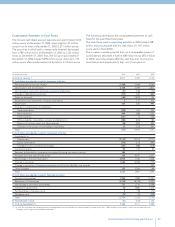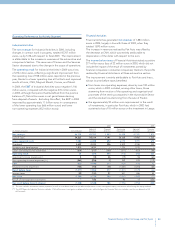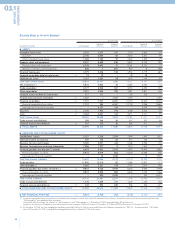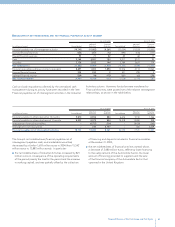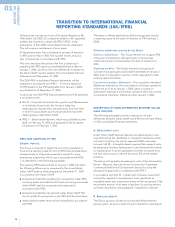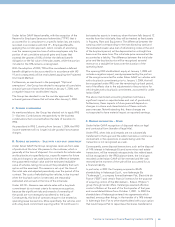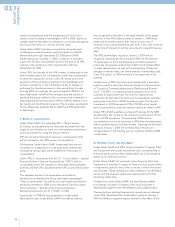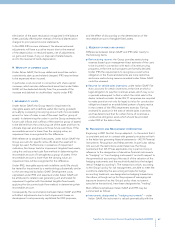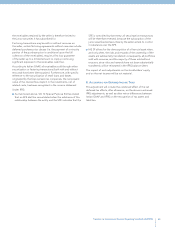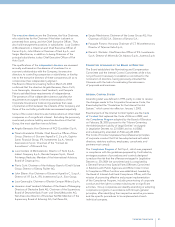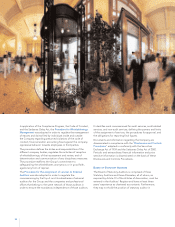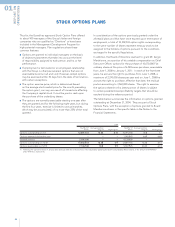Chrysler 2004 Annual Report Download - page 47
Download and view the complete annual report
Please find page 47 of the 2004 Chrysler annual report below. You can navigate through the pages in the report by either clicking on the pages listed below, or by using the keyword search tool below to find specific information within the annual report.
45
Transition to International Financial Reporting Standards (IAS/IFRS)
Under Italian GAAP these benefits, with the exception of the
Reserve for Employee Severance Indemnities (“TFR”) that is
accounted for in compliance to a specific Italian law, are mainly
recorded in accordance with IAS 19 – Employee Benefits,
applying the corridor approach, which consists of amortizing
over the remaining service lives of active employees only the
portion of net cumulative actuarial gains and losses that
exceeds the greater of 10% of either the defined benefit
obligation or the fair value of the plan assets, while the portion
included in the 10% remains unrecognized.
With the adoption of IFRS, TFR will be considered a defined
benefit obligation to be accounted for in accordance with IAS
19 and consequently will be recalculated applying the Projected
Unit Credit Method.
Furthermore, as mentioned in the paragraph “Optional
exemptions”, the Group has elected to recognize all cumulative
actuarial gains and losses that existed at January 1, 2004, with
a negative impact on stockholders’ equity.
The Group has decided to use the corridor approach for
actuarial gains and losses that will arise after January 1, 2004.
C. BUSINESS COMBINATIONS
As mentioned above, the Group has elected not to apply IFRS
3–
Business Combinations retrospectively to the business
combinations that occurred before the date of transition to
IFRS.
As prescribed in IFRS 3, starting from January 1, 2004, the IFRS
income statement will no longer include goodwill amortization
charges.
D. REVENUE RECOGNITION –SALES WITH A BUY-BACK COMMITMENT
Under Italian GAAP, the Group recognizes revenues from sales
of products at the time title passes to the customer, which is
generally at the time of shipment. For contracts for vehicle sales
and buy-backs at a specified price, a specific reserve for future
risks and charges is set aside based on the difference between
the guaranteed residual value and the estimated realizable
value of vehicles, taking into account the probability that such
option will be exercised. This reserve is set up at the time of
the initial sale and adjusted periodically over the period of the
contract. The costs of refurbishing the vehicles, to be incurred
when the buy-back option is exercised, are reasonably
estimated and accrued at the time of the initial sale.
Under IAS 18 – Revenue new vehicle sales with a buy-back
commitment do not meet criteria for revenue recognition,
because the significant risks and rewards of ownership of
the goods are not necessarily transferred to the buyer.
Consequently, this kind of contracts require to be treated as
operating lease transactions. More specifically, the vehicles sold
with a buy-back commitment expiring within 12 months are to
be treated as assets in inventory; when the term falls beyond 12
months from the initial sale, they will be treated as fixed assets
in Property, Plant and Equipment. The difference between the
carrying value (corresponding to the manufacturing cost) and
the estimated resale value (net of refurbishing costs) at the end
of the buy-back period, will be depreciated on a straight-line
basis over the same time. The initial sale price received will be
accounted as a liability. The difference between the initial sale
price and the buy-back price will be recognized as rental
revenue on a straight-line basis over the duration of the
operating lease.
The opening IFRS stockholders’ equity at January 1, 2004 will
include a negative impact, mainly represented by the portion
of the margin accounted for under Italian GAAP on vehicles sold
with a buy-back commitment prior to January 1, 2004, that will
be recognized under IFRS over the remaining buy-back period,
net of the effects due to the adjustments to the provisions for
vehicle sales with a buy-back commitment, accounted for under
Italian GAAP.
The above mentioned accounting treatment will have a
significant impact on reported sales and cost of goods sold;
furthermore, these impacts in future years will depend on
changes in volume and characteristics of these contracts
year-over-year. Notwithstanding this, these changes are
not expected to have material impact on reported earnings.
E. REVENUE RECOGNITION – OTHER
Under Italian GAAP recognition of disposals relies on legal
and contractual form (transfer of legal title).
Under IFRS, when risks and rewards are not substantially
transferred to the buyer and the seller maintains a continuous
involvement in the operations or assets being sold, the
transaction is not recognized as a sale.
Consequently, some disposal transactions, such as the disposal
of 14% interest in Italenergia Bis and some minor real estate
transactions, will be reversed retrospectively: the related asset
will be recognized in the IFRS balance sheet, the initial gain
recorded under Italian GAAP will be reversed and the cash
received at the moment of the sale will be accounted for as
a financial liability.
In particular, in 2001 the Company acquired a 38.6%
shareholding in Italenergia S.p.A., now Italenergia Bis
(“Italenergia”), a company formed between Fiat, Electricité de
France (“EDF”) and certain financial investors for the purpose
of acquiring control of the Montedison - Edison (“Edison”)
group through tender offers. Italenergia assumed effective
control of Edison at the end of the third quarter of that year
and consolidated Edison from October 1, 2001. In 2002 the
shareholders of Italenergia entered into agreements which
resulted, among other things, in the transfer of a 14% interest
in Italenergia from Fiat to other shareholders (with a put option
that would require Fiat to repurchase the shares transferred in



